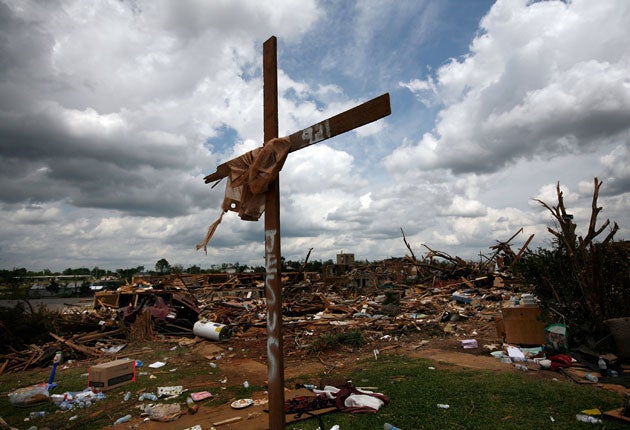Rupert Cornwell: Violent, extreme and contrary (the weather, that is)
Out of America: The larger-than-life meteorology of the US – its twisters, floods, and droughts – mirrors the nation

The British, it is said, love to talk about the weather. Personally, I've always found that to be an exaggeration: Britain's weather, to be honest, is not very interesting, though it can be a useful conversational filler if other topics are exhausted, or too ticklish to embark upon.
No, it's here in America that people really talk about the weather. One reason is the national addiction to numbers: rainfall, snow amounts, temperatures, windspeeds and so on are paradise for statisticians. A bigger one, though, is that American weather mirrors America itself, larger than life and prone to the most violent changes and contradictory extremes. It truly is worth talking about, and never more so than now.
I am no expert. But whether the reason is global warming, El Niño, La Niña, the alignment of the constellation Sagittarius, or simply punishment meted out by a capricious deity, this spring of which we have not yet reached the midpoint is already one for the record books.
The focus of the action, as usual, is the central and southern midsection of the country, a vast swathe of mainly flat territory bounded by the Rockies in the west, the Appalachian mountains in the east, and the Gulf of Mexico in the south, where cold air originating in the Arctic collides with the moist, warm airstream from the Gulf. In this region anything can happen, and this year it has.
You will already have read about the tornados. One day, 27 April, alone produced the deadliest single crop since 1974, in which some 300 people died in Alabama and five other southern states. It was once flippantly said that tornados were God's answer to trailer-parks. Not however the mile-wide monster that bore down on the university town of Tuscaloosa 11 days ago, reducing sturdy homes to rubble and laying waste entire neighbourhoods.
And yet worse may be ahead. Last month may have been the most severe April ever for tornados, with 300 separate ones registered, a figure eclipsing even 1974. But April is not even the most tornado-prone month. More usually occur in May and June, the outbreaks edging north along with the frontier between the cold and warm airmasses.
Then there are the floods. Obscured by the savage fury of the tornados is the fact that this is shaping up as one of the most serious flood years ever along the lower Ohio and lower Mississippi. A heavy snow melt to the north is partly to blame; also, the colliding warm and cold air masses got stuck for weeks, causing local rainfall near the rivers to exceed 2ft in some places during April alone.
On the lower Ohio, just before it joins the Mississippi, they're talking about the worst flooding since 1937. On Monday night army engineers had to blow a hole in a levee, creating a mile-long breach that deliberately flooded thousands of acres of some of the most fertile farmland on earth – all to lower water levels upstream, and prevent the town of Cairo, which sits at the confluence of the two rivers, from being submerged.
Cairo now seems safe but more levee breaches downstream may be necessary. There, the benchmark year is 1927, when in one of the worst natural disasters in US history, 27,000 square miles (over half the land area of England) were flooded, mostly in the states of Louisiana, Mississippi and Arkansas, and hundreds of thousands were made homeless.
Could it happen again? Probably not, given the vast improvements to the locks and levee system along the river since. But you never know; in 2005 New Orleans' levees were supposed to be strong enough to withstand a Katrina-force hurricane. And in the city of Vicksburg the Mississippi is currently at its highest since 1927, and rising still.
At least, you will point out, the central southern US isn't at any risk of drought any time soon. Amazingly, you would be wrong. Along the Mississippi, Noah's Ark might be in order – but 700-odd miles to the west, they're having to deal with a drought even more severe than the Dust Bowl of the 1930s.
Cimarron County, at the western end of the Oklahoma panhandle and ground zero of the Dust Bowl, is enduring its driest spell since 1908, more than seven months now, with less than a quarter-inch of rain in any given day. There won't be a repeat of the billowing, stifling black clouds of soil of 70 years ago (farming practices, like river levees, are much better these days). But the earth is bone dry, crops have been lost, cattle are dying and people are leaving. The last major drought in the central US, in 1988, is reckoned to be the costliest natural disaster in US history, Katrina included.
Floods, tornados, hurricanes and drought – it's like the Ten Plagues of Egypt relocated to the south central US. Doubters might consult a map in The New York Times last Sunday, of the most dangerous places to live in the US (in terms of natural disasters, not murders, that is). The winner was Dallas, with four other Texas cities in the top eight. Also represented were Louisiana, Arkansas and Alabama.
By comparison Los Angeles, constantly in dread of the Big One, is an oasis of meteorological tranquillity. Oh, by the way, they get earthquakes too around the Mississippi – as in the series of New Madrid quakes in 1811-12, the most powerful in North America in recorded history, an estimated 8 on the Richter scale, centred 50 miles south of Cairo. But I digress. Anyone want to talk about the weather?
Join our commenting forum
Join thought-provoking conversations, follow other Independent readers and see their replies
Comments